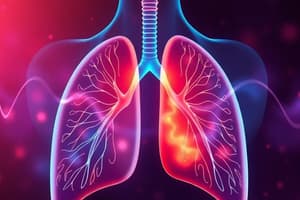Podcast
Questions and Answers
What is the primary physiological significance of residual volume (RV)?
What is the primary physiological significance of residual volume (RV)?
- It serves as a buffer for atmospheric pressure changes.
- It allows complete lung collapse after expiration.
- It prevents the total collapse of the lungs during forced expiration. (correct)
- It is essential for maintaining surface tension in the alveoli.
Which lung volume is NOT typically measured using spirometry?
Which lung volume is NOT typically measured using spirometry?
- Inspiration Reserve Volume (IRV)
- Tidal Volume (TV)
- Expiratory Reserve Volume (ERV)
- Functional Residual Capacity (FRC) (correct)
What occurs to smaller airways during forced expiration?
What occurs to smaller airways during forced expiration?
- They expand due to increased lung elasticity.
- They collapse before alveoli empty completely. (correct)
- They experience decreased positive pressure.
- They remain open and facilitate airflow.
What does the term 'functional residual capacity' refer to?
What does the term 'functional residual capacity' refer to?
Which lung volume is defined as the amount of air that can be forcefully exhaled after normal expiration?
Which lung volume is defined as the amount of air that can be forcefully exhaled after normal expiration?
How is the pressure in the intrapleural space described at the end of a normal tidal expiration?
How is the pressure in the intrapleural space described at the end of a normal tidal expiration?
Which lung volume measurement indicates the total volume of air that can be exhaled after a maximum inhalation?
Which lung volume measurement indicates the total volume of air that can be exhaled after a maximum inhalation?
What happens to lung capacity during maximum respiratory effort?
What happens to lung capacity during maximum respiratory effort?
Flashcards
Expiratory Reserve Volume (ERV)
Expiratory Reserve Volume (ERV)
The amount of air that can be forcibly exhaled after a normal tidal volume exhalation. It represents the volume of air that can be exhaled from the lungs beyond the tidal volume.
Inspiratory Capacity (IC)
Inspiratory Capacity (IC)
The total amount of air that can be inhaled after a normal tidal volume exhalation. It's the sum of tidal volume and inspiratory reserve volume.
Residual Volume (RV)
Residual Volume (RV)
The amount of air that remains in the lungs after a maximal exhalation. This ensures that some air always remains in the lungs, supporting lung function.
Tidal Volume (TV)
Tidal Volume (TV)
Signup and view all the flashcards
Total Lung Capacity (TLC)
Total Lung Capacity (TLC)
Signup and view all the flashcards
Functional Residual Capacity (FRC)
Functional Residual Capacity (FRC)
Signup and view all the flashcards
Vital Capacity (VC)
Vital Capacity (VC)
Signup and view all the flashcards
Inspiratory Reserve Volume (IRV)
Inspiratory Reserve Volume (IRV)
Signup and view all the flashcards
Study Notes
Lung Volumes
- Lung volumes are measured using spirometry.
- Normal lung volumes include: tidal volume (TV), inspiratory reserve volume (IRV), expiratory reserve volume (ERV), vital capacity (VC), functional residual capacity (FRC), residual volume (RV), inspiratory capacity (IC), and total lung capacity (TLC).
- FEV1 is also a relevant measurement.
- TV: Volume of air inhaled or exhaled in a single normal breath (approximately 0.5L).
- IRV: Maximum volume of air that can be inhaled after a normal inhalation (approximately 3.3L).
- ERV: Maximum volume of air that can be exhaled after a normal exhalation (approximately 1.0L).
- VC: Maximum amount of air that can be exhaled after a maximum inhalation (sum of TV, IRV, and ERV).
- FRC: Volume of air remaining in the lungs after a normal exhalation (ERV + RV).
- RV: Volume of air remaining in the lungs after a maximum exhalation.
- IC: Maximum volume of air that can be inhaled after a normal exhalation (TV + IRV).
- TLC: Total volume of air the lungs can hold (VC + RV).
- Measurements of RV and FRC are obtained using methods like nitrogen washout, helium dilution and plethysmography (not spirometry).
Residual Volume and Functional Residual Capacity
- After exhalation, the lungs don't empty completely.
- Residual volume (RV) is the air remaining in the lungs after a maximum exhalation.
- Functional residual capacity (FRC) is the volume of air remaining in the lungs after a normal exhalation (ERV + RV).
- Maintaining some air in the lungs is physiologically important; it reduces the energy needed for lung inflation.
Studying That Suits You
Use AI to generate personalized quizzes and flashcards to suit your learning preferences.




